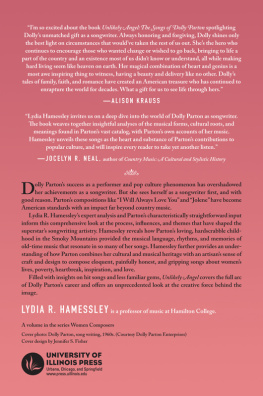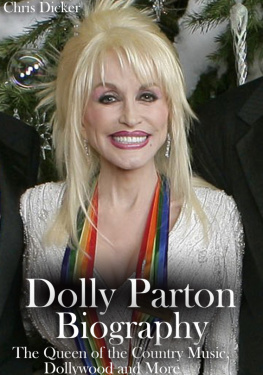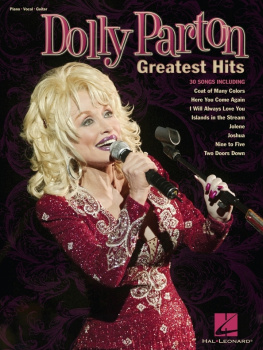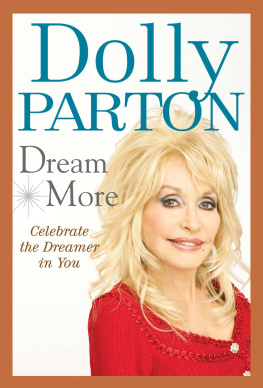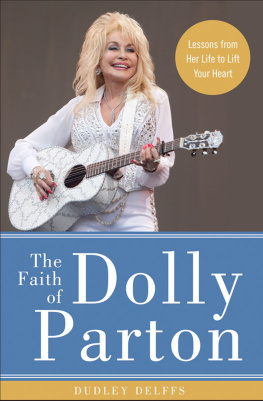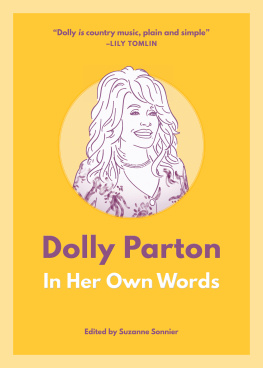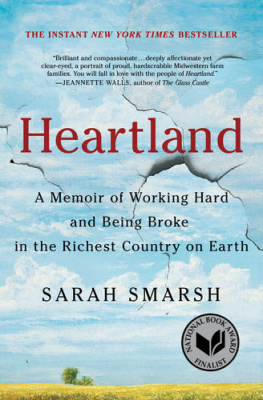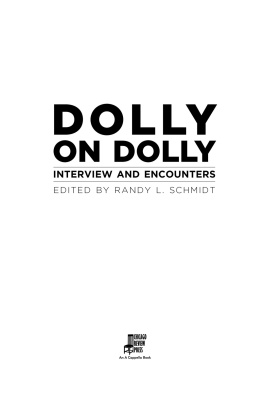Unlikely Angel
W OMEN C OMPOSERS
The short, readable books in the Women Composers series introduce significant women composers to students and general readers and provide a convenient reference for performers and scholars.
Series books treat the broadest range of women composers, combining concise biographical information with a comprehensive survey of works.
A list of books in the series appears at the end of this book.
Unlikely Angel
THE SONGS OF
DOLLY PARTON
LYDIA R. HAMESSLEY
Foreword by Steve Buckingham
Lyrics by Dolly Parton reproduced by permission of Velvet Apple Music.
Publication supported by grants from the AMS 75 PAYS Endowment of the American Musicological Society and the Judith McCulloh Endowment for American Music.
2020 by the Board of Trustees
of the University of Illinois
All rights reserved
Library of Congress Cataloging-in-Publication Data
Names: Hamessley, Lydia, author.
Title: Unlikely angel: the songs of Dolly Parton / Lydia R. Hamessley; foreword by Steve Buckingham.
Description: Urbana: University of Illinois Press, 2020. | Series: Women composers | Includes bibliographical references and index.
Identifiers: LCCN 2020020804 (print) | LCCN 2020020805 (ebook) | ISBN 9780252043529 (cloth) | ISBN 9780252085420 (paperback) | ISBN 9780252052408 (ebook)
Subjects: LCSH : Parton, DollyCriticism and interpretation. | Country musicHistory and criticism.
Classification: LCC ML 420. P 28 H 36 2020 (print) | LCC ML 420. P 28 (ebook) | DDC 782.42164092 [B]dc23
LC record available at https://lccn.loc.gov/2020020804
LC ebook record available at https://lccn.loc.gov/ 2020020805
For Sam
The music in my heart I bore,
Long after it was heard no more.
The Solitary Reaper, William Wordsworth
Contents
Foreword
A ccording to All Music Guide I have produced twenty albums with Dolly Parton. More important to me is the fact that Dolly and I have been friends since 1989. When Professor Lydia Hamessley contacted me about a book she was writing on Dolly I was initially a bit skeptical. Over the decades I have been asked to do countless interviews for newspapers, documentaries, magazines and books about Dolly. I did do some but declined most.
However, Professor Hamessley explained that she wanted to concentrate on Dolly Parton the songwriter, musician and artist. This certainly struck a note with me since most articles about Dolly deal with her appearance, larger than life personality and, very often, rumors. I was extremely interested to relate some of my musical experiences and a fascinating journey with one of the most incredibly talented artists in the world.
After several phone conversations with Professor Hamessley, I spoke to Dolly about this book and she wholeheartedly embraced the project saying, We should do anything we can to help her with this. Professor Hamessley submitted a list of questions that were impressive in their thoroughness. Typically, Dolly gave the questions much thought and then, in one evening, recorded all of her responses. Im sure the readers of this book will find some of Dollys answers to be fascinating.
Over the decades Dolly and I sometimes talked about how the cartoon she had created (her word, not mine) often overshadowed her talent as a songwriter and musician. We always strove to put the music first. This was especially true in 1999 and 2000 when we recorded the albums The Grass Is Blue and Little Sparrow. Both projects featured sparse, acoustic-based Bluegrass/Mountain music where there was no place to hide as a vocalist. I assembled Gods Bluegrass Band, as Dolly called the musicians surrounding her. Simply put, they were the best in the business and everyone rose to the occasion. For both albums all the tracks were recorded in less than two days each. The spontaneity and talent on display were electrifying as Dollys vocals pushed the musicians and their playing drove her. Critics were overwhelmingly positive in their reviews and both albums won Grammys: The Grass Is Blue for Best Bluegrass Album and Shine from the Little Sparrow album for Best Female Country Vocal Performance. Her music took precedence over the image.
Professor Lydia Hamessley has worked for many years to capture behind-the-scenes stories describing Dollys influences, songwriting and musicality. I believe her amazingly detailed and researched book will open many eyes to one of the most iconic artists in history.
Make no mistake, Dolly Parton is a phenomenally gifted songwriter who never runs out of ideas. Just ask her peers. And dont let the long fingernails fool you! She is extremely adept on guitar, banjo, dulcimer and autoharp. She has a great rhythm or lick with her right hand. Just ask the world class musicians who have played with her. As a singer, she has never failed to astound all of us who have worked with her. Just ask another gifted vocalist such as Alison Krauss.
Finally, Dolly IS one of the kindest and most considerate people in a tough, demanding and often cynical business. Just ask me.
Steve Buckingham
Nashville, Tennessee /
Virginia Beach, Virginia
Preface and Acknowledgments
Who doesnt love Dolly Parton? Someone without a soul, thats who.
M y first memories of Dolly Parton are from my childhood. My parents always watched The Porter Wagoner Show, and although I did not pay much attention to the program, I noticed Dolly. She was the girl singer with the big wigs and flashy clothes. In the mid-1970s, I loved the song Jolene, and, in the 1980s, I got to know Dolly better through her delightful performances in 9 to 5 and Steel Magnolias. Later, in the 1990s, it was impossible not to know the song I Will Always Love You. When I eventually discovered that Dolly wrote the song, I immediately sought out her recording and was dumbstruck at how poignant and heartbreakingly beautiful it was. On a visit to the Country Music Hall of Fame, I saw one of her polyester pantsuits on a Dolly-proportioned mannequin and was astonished at how small she was. White Limozeen was the first Dolly album I bought, and when she released The Grass Is Blue I was thrilled. In 2016, I could not resist having my picture taken with a life-size cardboard Dolly at a welcome stop as I entered Tennessee on IH-81 on my way to Dollywood.
When Laurie Matheson, director of the University of Illinois Press, invited me to write a book on Dolly, I asked my friend and fellow musicologist Suzanne Cusick for her advice, and she said, If Id been asked to write a book on Dolly, Id jump on that like a duck on a June bug. So I began my deeply rewarding, in-depth exploration of Dollys music. When I told students in my country music history course that I was writing this book, one of them asked, Does that mean you have to listen to all of Dollys albums? I expect they viewed such a project as an endless, tedious succession of term papers, rather than the enjoyable adventure it has been. My reply to the student: It means I get to listen to all of her albums. And attend her concerts, watch her films, read her books, visit Dollywood, and read and listen to countless interviews with Dolly.

